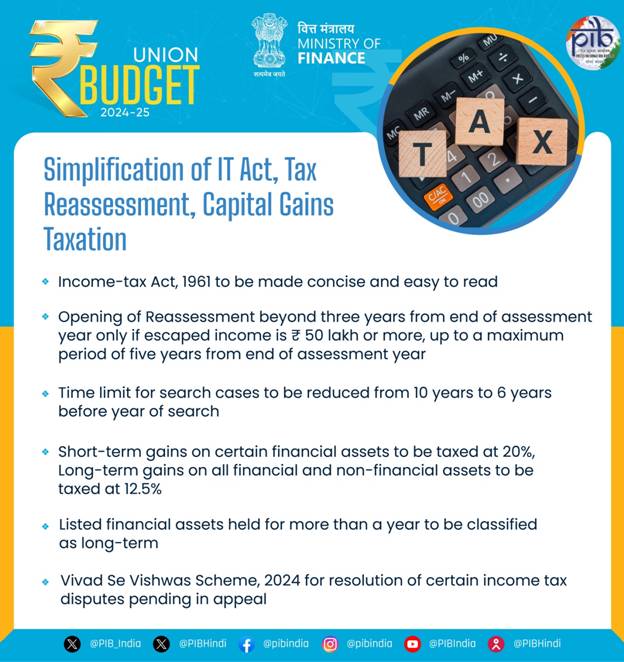While presenting the Union Budget 2024-2025 in Parliament today, the Union Minister for Finance & Corporate Affairs, Smt. Nirmala Sitharaman said the Budget with its focus on the nine identified priorities expedites the journey towards the goal of Viksit Bharat.
Emphasizing that it has been a consistent endeavour of the government to simplify taxation, improve tax payer services and reduce litigation, the Finance Minister observed that it has been appreciated by the tax payers. 58 per cent of corporate tax came from the simplified tax regime in financial year 2022-23 and more than two-thirds have availed the new personal income tax regime in the last fiscal year as per available data, she highlighted.
Pursuing the agenda of simplifying taxation, the Union Finance Minister outlined a number of measures in her Budget speech. Announcing a comprehensive review of the Income-tax Act, 1961 in six months to make it concise and lucid, the Smt. Nirmala Sitharaman said, “This will provide tax certainty to the tax payers reducing disputes and litigation.”

In another measure to reduce tax-uncertainty and disputes, a thorough simplification of reassessment has been proposed. Outlining the proposal, the Finance Minister said that an assessment hereinafter can be reopened beyond three years from the end of the assessment year only if the escaped income is ₹ 50 lakh or more, up to a maximum period of five years from the end of the assessment year. The Finance Minister announced that in search cases, a time limit of six years before the year of search, as against the existing time limit of ten years.
Initiating tax simplification process for Charities and of TDS in the Finance Bill, Smt. Nirmala Sitharaman proposed that the two tax exemption regimes for charities are to be merged into one. The 5 per cent TDS rate on many payments is being merged into the 2 per cent TDS rate and the 20 per cent TDS rate on repurchase of units by mutual funds or UTI is being withdrawn. TDS rate on e-commerce operators is proposed to be reduced from one to 0.1 per cent. Moreover, credit of TCS is proposed to be given in the TDS to be deducted on salary. Further, decriminalization of delay for payment of TDS up to the due date of filing statement for the same, the Union Minister added.
Highlighting the digitalization of all the major tax payer services under GST and most services under Customs and Income tax, Smt Nirmala Sitharaman announced that all the remaining services including rectification and order giving effect to appellate orders will also be digitalized and made paper-less over the next two years.
Acknowledging the good results visible at various appellate fora, the Union Finance Minister emphasized that litigation and appeals will continue to receive highest attention of the government. Pursuing this objective, Vivad se Vishwas Scheme, 2024 for resolution of certain income tax disputes pending in appeal has been announced in the Budget speech. Further, it has been proposed to increase monetary limits for filing appeals related to direct taxes, excise and service tax in the Tax Tribunals, High Courts and Supreme Court to ₹ 60 lakh, ₹ 2 crore and ₹ 5 crore respectively. Focusing on reducing litigation and ensure certainty in international taxation, the scope of safe harbor rules will be expanded along with streamlining the transfer pricing assessment procedure, the Finance Minister added.
Speaking on deepening the tax base, Smt. Sitharaman announced two key measures. First, Security Transactions Tax on futures and options of securities is proposed to be increased to 0.02 per cent and 0.1 per cent respectively. Second, taxing of income received on buy back of shares has been proposed as a measure of equity, the Minister added.
Elaborating on the implication of these proposals, Smt Sitharaman concluded that revenue of about ₹ 37,000 crore – ₹ 29,000 crore in direct taxes and ₹ 8,000 crore in indirect taxes – will be forgone while revenue of about ₹ 30,000 crore rupees will be additionally mobilized. Thus, the total revenue forgone is about ₹ 7,000 crore annually.
 Matribhumi Samachar English
Matribhumi Samachar English



